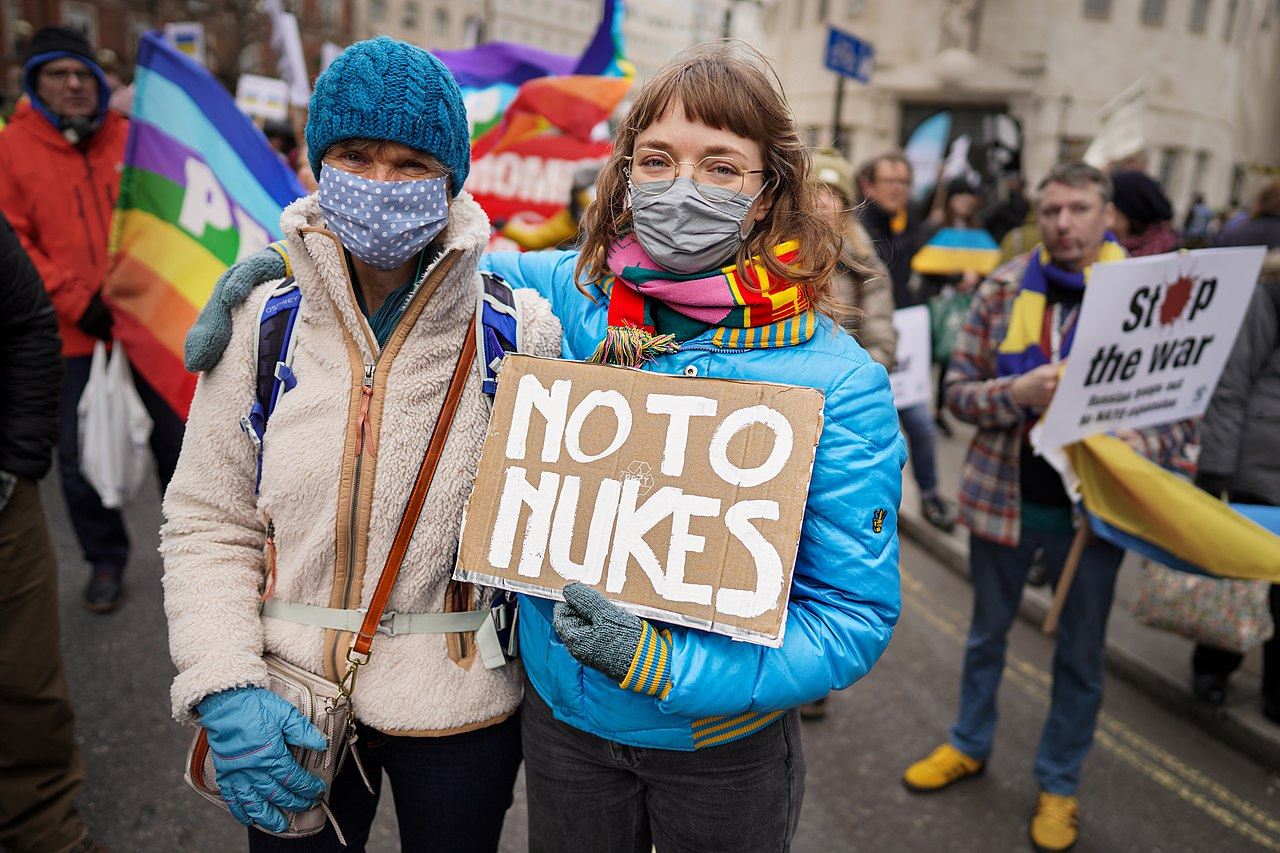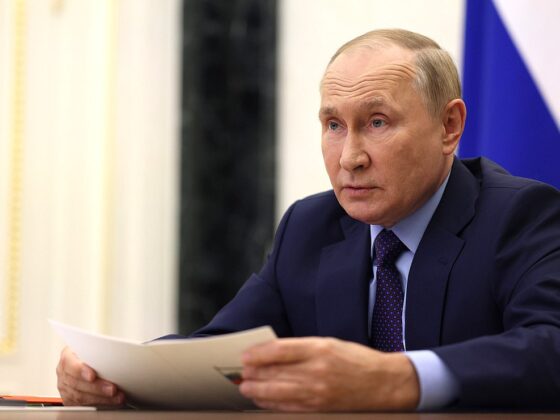“No matter who tries to stand in our way, or all the more so, create threats for our country and our people, they must know that Russia will respond immediately, and the consequences will be such as you have never seen in your entire history,” said President Vladimir Putin on February 24 while launching his “special military operation” against Ukraine. His speeches have hinted at the possibility of Russia using nuclear weapons to de-escalate the conflict by pressuring potential allies of Ukraine. Foreign Minister Sergey Lavrov has echoed his boss by pointing to the “the essence” of the high likelihood of nuclear war with NATO due to Western armaments going to Ukraine.
Nuclear war narratives are back in the political language—now even stronger than during the Cold War. Playing with atomic escalation threats reveals inherent parts of contemporary Kremlin strategy while breaking the mold of international affairs. Russia has tried to blackmail NATO with nuclear threats to coerce its members away from supporting Ukraine, a move that paradoxically refreshed the functions attributed to their dormant weapons. Russia has been showcasing how nuclear weapons have gradually changed from obsolete tools of conflict to inherent drivers of power projection and an umbrella for securing spheres of influence.
Nuclear Strategy and the Ukraine War
This year’s international security crisis has been accompanied by the tremendous growth of the communicative role of nuclear weapons between world actors. Back in 2000, Moscow had quietly proclaimed the possible use of nuclear weapons in conventional conflicts “in critical circumstances,” with an accent on the possibility of nuclear use in a regional war. Nuclear escalation has since been presented as a means of terminating conflicts “on terms favorable to the Russian Federation.” The 2014 Russian Military Doctrine states nuclear weapons can be used “when the existence of the state is in jeopardy”—although the nature of a qualifying threat has never been clarified. Before 2022, there was an understanding that the notion of an “existential threat” to Russia included territorial integrity and the political regime’s survival. It also included potential defeat in a large-scale conventional war, with Serbia in 1999 being the base scenario. There were doubts about whether it included vital spheres of influence. This winter, however, Putin decided to take notice of the danger of Western policies and NATO infrastructure potentially heading to Ukraine as pretexts for invading:
“For the United States and its allies, it is a policy of containing Russia, with obvious geopolitical dividends. For our country, it is a matter of life and death and our historical future as a nation. This is not an exaggeration; this is a fact. It is not only a very real threat to our interests but to the very existence of our state and to its sovereignty.”
The “special operation” against Ukraine was apparently justified by an officially declared existential threat to the Russian state. But can an initiated war on another state’s territory be qualified as an existential threat to Russia? Has there been a de facto evolution of the Russian nuclear doctrine with offensive deterrence at the forefront of state policy?
The 2020 “Basic Principles of State Policy on Nuclear Deterrence” is the latest document describing Russia’s nuclear strategy. It is the sum of excerpts from all major Russian documents regarding situations and “red lines” of nuclear weapons use. The force of the “Basic Principles” are the accents placed at crucial points that Moscow’s leaders had been speculating about and trying to insert for a long time. First, according to the Kremlin, the main aim of Russian nuclear deterrence is “preventing the escalation of military actions and their termination on favorable Russian terms,” which, in light of the violent war on Ukraine, has made Russian nuclear threats credible. It seeks to codify deterring possible NATO interferences (in Ukraine and regionally) while incentivizing the use of nuclear weapons if a war does not go Moscow’s way. Such reflections have been reinforced by Russian pro-Putin experts such as Sergey Karaganov, who have vocalized its most radical ideas:
“Russia cannot afford to ‘lose,’ so we need a kind of a victory. And if there is a sense that we are losing the war, then I think there is a definite possibility of escalation.”
Indeed, many in Moscow see the war against Ukraine as a proxy war between the West and Russia for crafting the future world order. Meanwhile, the nuclear casus belli in the “Basic Principles” is connected with two aspects. One is credible information on the launch of ballistic missiles toward Russian territory based on “launch warnings.” However, Russia has intentionally ignored the type of warhead (either conventional or nuclear) that may be used on a missile to emphasize that any projectile launched at it may trigger a nuclear response. Any failure of the Russian early warning system may lead to nuclear escalation. Such a posture—from an erstwhile superpower—does not encourage local or global stability and discredits the Putin regime during the largest European turbulence since World War II.
The second stated use would be responding to an attack by an adversary against critical Russian governmental or military sites, the “disruption of which would undermine nuclear forces response actions.” Because a significant part of the Russian military infrastructure used for attacking Ukraine is concentrated in Crimea, one cannot exclude missile strikes on this territory by Ukraine—as may have already happened in early August when a Russian airfield there was struck. During this time, some Crimean bridges were also targeted. Earlier, Russia had declared that it would react with a “doomsday promise” in case any Crimean bridges were destroyed. Ukraine did not directly claim responsibility for the attacks, and Moscow said only that munitions had exploded through negligence. Fortunately, escalation was avoided, but we can see the dangerous game of harsh words, violence, and red lines being drawn and re-drawn.
Scenarios of Russian Nuclear Weapon Use in Today’s War
Besides the multiple threats coming from the Russian authorities, the different possibilities of interpretation of the Russian nuclear doctrine, and the wide use of dual-use-capable weapons in Ukraine, there is a range of other concerning factors. Russia’s decision-making mechanisms are known to be obscure. Its army disregarded nuclear security when it created fortifications and took control of the Chornobyl nuclear power plant, and struck the Zaporizhzhia nuclear plant, either of which could have resulted in a nuclear catastrophe. Their behavior shows a lack of general awareness among Russian soldiers and officers about nuclear materials and the potential collateral damage that may occur. It shows how unpredictable and non-professional Russian actions may ignite a nuclear catastrophe.
Taking a measured view, one can foresee three most probable scenarios for the use of nuclear weapons during the war on Ukraine. One might be due to a highly successful counteroffensive operation by Ukrainian forces, which would “threaten Putin’s political positions and the stability of his regime.” In such a situation, the Kremlin may use tactical nuclear weapons. This idea is echoed by Richard Betts, who considers possible escalation when Russia’s main aim would be to avoid defeat “by shocking Ukraine and its NATO supporters into standing down.” Indeed, if the Kremlin closely connects its political existence with the possibility of taking the bigger part of Ukraine, this scenario retains credibility, especially in light of increased weapons supplies from the West and some successes of the Ukrainian army.
The second might be an escalation of the war involving Crimean territory or missile strikes on Russia itself. It may result from Ukraine’s troops’ counteroffensive operations and also the application of new Western artillery systems in those areas. In May 2022, Putin emphasized Russia had “sufficient quantities [of weapons] to strike those facilities that we are not attacking so far.” He hinted at the possible escalation of the war if long-range missile systems were supplied to Ukraine. However, the credibility of this scenario is fairly low as there is reason to believe that NATO’s nuclear shield is a deterrent for Russia. To solidify this, strong signaling from NATO should leave no doubts about the reaction of the alliance toward Moscow’s nuclear provocations.
The third case could be an unintentional nuclear escalation resulting from Russia’s early warning systems due to possible malfunction or misperception, such as a spontaneous clash between Russian and NATO aircraft. In this scenario, a small mistake may lead to swift nuclear escalation because of high tensions, animosity, and disinformation.
Conclusion
Russian rhetoric became sprinkled this year with nuclear-use references that are meant to serve several purposes. Among the many reasons the Kremlin gave for its invasion of Ukraine, a vehemently expressed one was to prevent NATO military facilities from being potentially deployed there. Putin also wanted Ukraine’s actual and possible allies to feel a fear factor, both at the launch of the invasion and later, as the conflict dragged on and Russia experienced losses. We can expect Moscow’s nuclear rhetoric to rise when it senses its upper hand slipping, even if it may add to geopolitical misinterpretations. Further, battlefield desperation or an unexpected military mishap could trigger a Russian nuclear release. But on the most important underlying query: if Ukraine chooses a future aligned with Europe, is the existence of the Russian state in jeopardy? No.
Polina Sinovets is Associate Professor in the Faculty of International Relations and head of the Odesa Center for Nonproliferation at Odesa I. I. Mechnikov National University, Ukraine.











